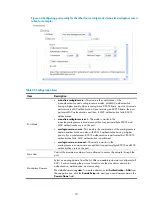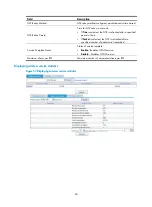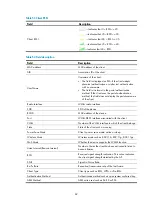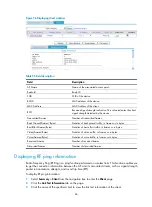
69
Table 44
Configuration items
Item Description
Port Mode
•
userlogin-secure
—Perform port-based 802.1X authentication for access
users. In this mode, multiple 802.1X authenticated users can access the
port, but only one user can be online.
•
userlogin-secure-ext
—Perform MAC-based 802.1X authentication for
access users. In this mode, the port supports multiple 802.1X users.
Max User
Control the maximum number of users allowed to access the network through
the port.
Mandatory Domain
Select an existing domain from the list.
The default domain is
system
. To create a domain, select
Authentication
>
AAA
from the navigation tree, click the
Domain Setup
tab, and type a new
domain name in the
Domain Name
combo box.
•
The selected domain name applies to only the current wireless service,
and all clients accessing the wireless service use this domain for
authentication, authorization, and accounting.
•
Do not delete a domain name in use. Otherwise, the clients that access the
wireless service will be logged out.
Authentication Method
•
EAP
—Use EAP. With EAP authentication, the authenticator encapsulates
802.1X user information in the EAP attributes of RADIUS packets and
sends the packets to the RADIUS server for authentication; it does not need
to repackage the EAP packets into standard RADIUS packets for
authentication.
•
CHAP
—Use CHAP. By default, CHAP is used. CHAP transmits only user
names rather than passwords over the network. Therefore this method is
safer.
•
PAP
—Use PAP. PAP transmits passwords in plain text.
Handshake
•
Enable
—Enable the online user handshake function so that the device can
periodically send handshake messages to a user to check whether the user
is online. By default, the function is enabled.
•
Disable
—Disable the online user handshake function.
Multicast Trigger
•
Enable
—Enable the multicast trigger function of 802.1X to send multicast
trigger messages to the clients periodically for initiating authentication. By
default, the multicast trigger function is enabled.
•
Disable
—Disable the 802.1X multicast trigger function.
IMPORTANT:
For a WLAN, the clients can actively initiate authentication, or the AP can
discover users and trigger authentication. Therefore, the ports do not need to
send 802.1X multicast trigger messages periodically for initiating
authentication. HP recommends that you disable the multicast trigger function in
a WLAN because the multicast trigger messages consume bandwidth.
5.
Configure the other four port security modes:
Summary of Contents for MSR SERIES
Page 17: ...xv Documents 835 Websites 835 Conventions 836 Index 838 ...
Page 20: ...3 Figure 3 Initial page of the Web interface ...
Page 42: ...25 Figure 13 Firefox Web browser setting ...
Page 59: ...42 Figure 27 Checking the basic service configuration ...
Page 73: ...56 Figure 35 Sample interface statistics ...
Page 156: ...139 Figure 139 Rebooting the 3G modem ...
Page 168: ...151 Figure 152 Configuring Web server 2 ...
Page 174: ...157 Figure 158 Configure the URL filtering function ...
Page 242: ...225 Figure 233 Enabling the DHCP client on interface Ethernet 0 1 ...
Page 247: ...230 Figure 236 The page for configuring an advanced IPv4 ACL ...
Page 255: ...238 Figure 241 Advanced limit setting ...
Page 298: ...281 e Click Apply 2 Configure Router B in the same way Router A is configured ...
Page 400: ...383 Figure 387 Verifying the configuration ...
Page 405: ...388 ...
Page 523: ...506 Figure 530 Ping configuration page ...
Page 775: ...758 Figure 785 Configuring a jump node ...






























